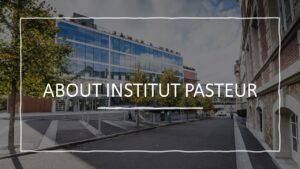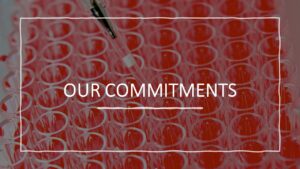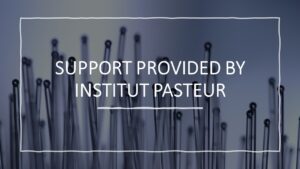ABOUT INSTITUT PASTEUR
The Institut Pasteur is a private, non-profit foundation with recognized charitable status entrusted with four core missions of public interest:
- Research: more information here
- Education: more information here
- Health: more information here
- Innovation: more information here
The Institut Pasteur is a globally recognized leader in infectious diseases, microbiology and immunology. Other avenues of investigation include cancer, genetic and neurodegenerative diseases, genomics and developmental biology.
The Institut Pasteur develops many major international projects in partnership with the main international scientific authorities such as the World Health Organization, and many research institutions, foundations, universities and other private actors worldwide.
Since June 2021, the Institut Pasteur is a research partner organization, member of Université Paris Cité community (more information here).
The Institut Pasteur is also part of the Pasteur Network, a human and scientific community with more than 30 members in over 20 countries working together to help improve global health.
Discover the Instituts Pasteur in the world here
Institut Pasteur at a glance, in 2022:
– 2,934 staff members on campus Paris. Among them, roughly half are scientists (permanent scientists and post-docs or PhDs), a quarter of them are engineers and technicians and a quarter of them are administrative and technical support staff. Personnel are either hired by the Institut Pasteur (80%, including administration, maintenance and technical facilities) or paid by government agencies (20%, referred to as “OREX” staff).
– 78 different nationalities, 59,5% of women, 98% Gender Equality Index.
– 142 research units, 32 technological platforms and core facilities, 12 research departments
OUR COMMITMENTS TO PROVIDING AN ATTRACTIVE AND RESPONSIBLE WORKING ENVIRONMENT
The activities of the Institut Pasteur are constantly part of a responsible, societal and environmental approach.
Discover all our commitments here
- Our Ethics commitment: the Institut Pasteur Ethics Charter was drawn up by the Institut Pasteur Ethics Committee (CEIP) and published under the authority of the senior management team. The Ethics Charter applies to all employees whether paid by Institut Pasteur or other institutions. It states the principles to ensure that research is conducted with integrity, respect for human dignity, fairness and responsibility.
See the Ethics charter here - Our Open Science commitment: the Institut Pasteur has been acting in favor of Open Science by adopting two founding texts in May 2021: a Charter for Open Access to publications and a Policy for the management and sharing of research data and software code.
Learn more about open science at Institut Pasteur here - Our research with animal models: the Institut Pasteur is fully aware of its responsibilities; it is committed to protecting the well-being of animals used for research, especially through strict compliance with regulatory provisions, and to encouraging the development of experimental methods that avoid using animals wherever possible.
Learn more about animal model here - Diversity, Equity and Inclusion (DEI): the Institut Pasteur is proud to be an equal opportunity workplace fighting against all discriminations and where everyone has a part to play in diversity.
Discover our diversity, equity and inclusion commitments here - Our Gender Equality Plan: as part of its commitment to gender equality in the workplace, the Institut Pasteur has adopted a Gender Equality Plan (GEP).
Discover our gender equality plan here - Our “HR Excellence in Research” accreditation: in December 2021, the Institut Pasteur obtained the HR Excellence in Research Award from the European Commission and has embarked on a process of continuous improvement regarding recruitment and working conditions for scientists, while strengthening its attractiveness at the international level.
Learn more about the HR excellence in research accreditation: click here - Our support to the United Nations Global Compact: the Institut Pasteur supports the United Nations Global Compact and its 10 principles on human rights, labor standards, environmental protection and anti-corruption.
See the UN Global compact site : click here - Our commitment in « Paris Action Climat Biodiversité » pact: the Institut Pasteur has signed the “Paris Action Climat” of the City of Paris in 2020. The pact was revised in 2022 and became Paris Action Climat Biodiversité (Climate Biodiversity Action Plan) with economic and institutional actors, acting as key players in Paris’ commitment for climate.
See the pact (in French): click here
SUPPORT PROVIDED BY THE INSTITUT PASTEUR
- Get personalized career support – Career Development Service for Scientists (CARE for scientists)
The Institut Pasteur offers Masters students, PhD students, postdoctoral fellows, engineers and researchers a personalized career support program through a dedicated service.
The missions of the service are:
– To guide scientists at all stages of their career to develop a career plan that reflects their aspirations (CARE for your future);
– To support members of the postdoctoral community as they arrive and settle into the Institut Pasteur and in their personal and professional well-being and development (CARE for postdocs);
– To help the Institut Pasteur implement structural and cultural changes by developing two policies (CARE for institutional change): (i) The policy for equality in the workplace, as transposed in the Institut Pasteur Gender Equality Plan, which upholds the values of diversity, equity and inclusion (CARE for DEI); (ii)The European Union’s Human Resources Strategy for Researchers (HRS4R), supported by the conferral of the European HR Excellence in Research Award (CARE for HR excellence in research)
See more: click here - Maximizing the success of your research projects – the Grants Office:
The Grants Office team is dedicated to providing expert and personalized support to maximize the success of projects financed by external funders (ANR, the European Commission, the NIH, etc.). Starting from strategic monitoring, meticulous proposal preparation (including help in grant writing), to rigorous project monitoring, the team is dedicated to optimizing each phase of the project, ensuring the success of your initiatives at Institut Pasteur. - Mentoring : Institut Pasteur has implemented a mentoring process dedicated to young PIs. Each G5 group leader is assigned a mentor within the first 3 months of his or her arrival. A mentorship agreement between the mentee and the mentor defines the mentee’s expectations from the mentorship and also the mentor’s commitment with the mentee.
- The Young Researcher Association of Institut Pasteur (StaPa)
StaPa is an association of young researchers open to all young researchers of the Institut Pasteur including short-term interns, Master and PhD students and postdocs. The aims of the association are both social and scientific. Social, to welcome and integrate young researchers to the Institute and promote interactions by organizing social events. Scientific, to promote exchanges (scientific, technical, language-based, etc.) between young researchers and with experienced scientists by organizing scientific meetings, seminars and workshops
For more informations : http://stapa.ovh
Contact : bureau.stapa@pasteur.fr


